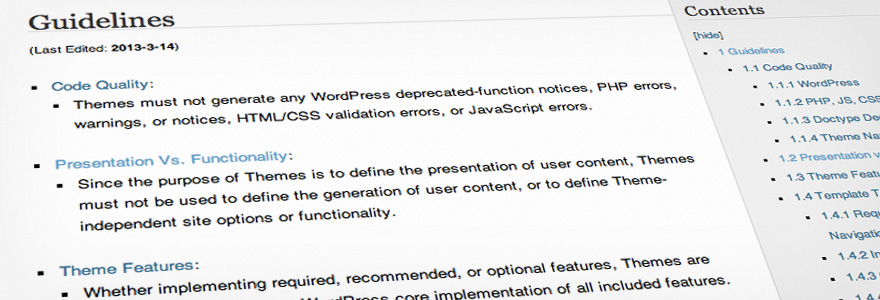For those of you looking for a WordPress theme, if you’re not aware of WordPress.org theme review process, I recommend that you read Theme Review article at WordPress Codex. If you’re looking for a WordPress theme, there’s hardly a better place to tell you what you should expect from it. In case Codex article is too technical, and for non-developers some parts certainly are, you might want to read our post on what users should and shouldn’t expect from a WordPress theme first.
Now, let’s take a look at some of the most glaring items in Theme Review Codex article and why tons of commercial themes would fail review process.
Presentation vs. Functionality
Since the purpose of Themes is to define the presentation of user content, Themes must not be used to define the generation of user content, or to define Theme-independent site options or functionality.
Themes that handle more than presentation of user content is something I wrote about before. You might want to check why WordPress themes should never lockdown their users, why a WordPress theme should never do plugin’s work and why bloated themes are bad for you.
Adding Links to Setting Page(s)
Themes are required to use the add_theme_page() function to add the Theme Settings Page to the Appearance menu, rather than using add_menu_page() to add a top-level menu.
There’s a good reason for this. Imagine a first time WordPress user running a website with a theme that adds its own top-level menu page. Let’s say it’s labeled Theme1 Menu, located between Tools and Settings in the dashboard menu and has three submenu items — General Settings, Fonts and SEO.
This will work just fine, until our user decides it’s time to switch to a new theme, one that adds a top-level menu item labeled Theme2 Menu just above Posts, with its own submenu, of course. For an experienced user this change will not present a big problem, but with roughly one in five websites being powered by WordPress, not all of its users are highly skilled.
For new users, once a menu item they were using disappears, something is broken. Theme Review guidelines require all themes that have settings pages to add a link to them as a submenu item under Appearance menu. This way users of all skill levels know exactly where to look for a theme settings page, if there is one.
Themes Should Never add a Favicon Automatically
Themes are recommended not to implement custom favicon functionality. If implemented, favicon functionality is required to be opt-in, and disabled by default. If implemented, favicon functionality is required to support user-defined favicon images.
Unless the theme is used for its demo website, this one is pure common sense. Supporting person or company that’s developing your theme is one thing, labeling your website in a way that promotes someone else’s brand is completely different.
How likely is it that you’d use a theme that doesn’t forces you to use a certain logo? I can guess the answer to that question and can’t see how favicon is any different. And as far as the “recommended not to implement custom favicon functionality” part is concerned, well, favicons ARE plugin territory. Even if you do use your own custom favicon, do you want to set it up again once you switch to a new theme?
Backward compatibility
Themes must not support backward compatibility for more than two prior major WordPress versions. Themes should not support backward compatibility for more than one prior major WordPress version.
Given how easy it is to upgrade WordPress to latest version, this one is a no-brainer. Yes, I know WordPress statistics show that around 30% of WordPress websites are powered by what can be classified as “more than two prior major WordPress versions”, but I doubt someone who hasn’t upgraded WordPress for almost three years will actually take the time to find a new theme. And I certainly hope you’re not running latest WordPress version (3.5.1) and basing your theme selection on whether it will work with version 3.1 :)
Those are four main reasons why so many commercial themes (I don’t call them premium because the fact that it’s not free doesn’t make it premium) can’t be given away for free. Luckily, it seems like commercial themes market is evolving. A new marketplace, called Creative Market, is featured on wordpress.org homepage and it looks like Automattic Theme Team will be selling its themes there. In addition to that, Envato is reinforcing its review teams, that should definitely increase quality of ThemeForest themes and hopefully bring them closer to WordPress theme development best practices as well.
